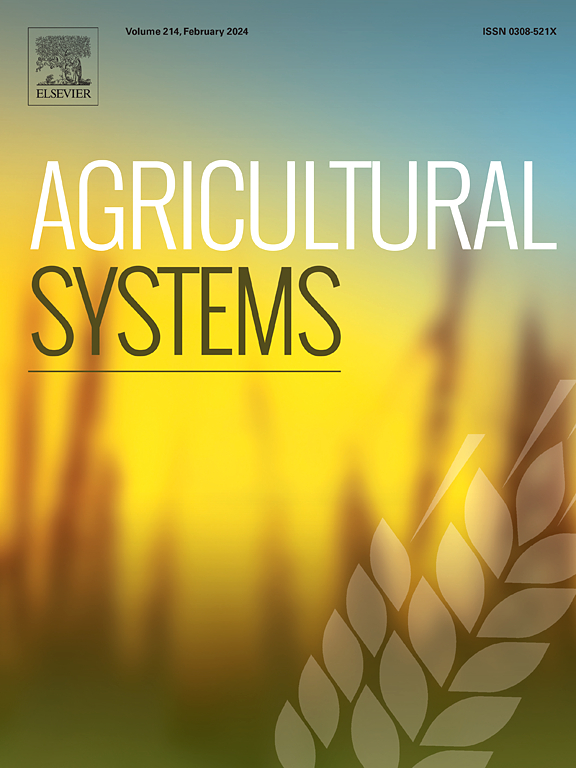规模重要吗?本地采购如何影响荷兰循环食品系统的土地使用
IF 6.1
1区 农林科学
Q1 AGRICULTURE, MULTIDISCIPLINARY
引用次数: 0
摘要
了解资源闭环在不同空间尺度上的潜力和影响,需要结合当地生物物理生产环境和粮食需求背景的粮食系统方法。目的:我们调查了荷兰循环食品系统中当地食品采购如何影响土地利用和土地利用模式。方法采用粮食系统优化模型FOODSOM,结合不同地点的粮食和饲料作物产量,对荷兰各省不同粮食自给水平的情景进行比较。结果和结论:在不限制当地采购的情况下,荷兰人口可以利用54%的现有农业用地获得健康饮食,如果在每个省内采购90%的消费食品,则可将这一比例增加约5万公顷至57%。增加省(地方)采购使荷兰的土地利用从人口密度低的省份的高产粘土和沙质土壤转向人口密度高的省份的不太合适的泥炭和湿土。荷兰的总土地需求保持稳定,高达当地采购的50%,因为这可以在所有省份实现,同时避免低产土壤。意义我们表明荷兰有足够的土地来满足健康饮食的食物需求。在省级尺度上,循环性要求使用较少的合适土地,但由于全国各地的高肥力和相对较小的产量差异,只略微增加了土地利用总面积。在土壤产量差异较大的国家,就地采购将更大幅度地增加土地利用。当地采购的目标程度还可能取决于与其他地方更多的运输和生产相比,额外的土地利用对温室气体和营养物质净排放以及生物多样性的影响。本文章由计算机程序翻译,如有差异,请以英文原文为准。

Does scale matter? How local sourcing affects land use for circular food systems in the Netherlands
CONTEXT
Understanding the potential and impacts of closing resource loops on different spatial scales requires a food systems approach with local context of the biophysical production environment and food demand.
OBJECTIVE
We investigated how local sourcing of food affects land use and land use patterns in a circular food system in the Netherlands.
METHODS
We used the food systems optimization model FOODSOM, along with site specific crop yields for a range of food and feed crops, and compared scenarios with varying levels of food self-sufficiency of Dutch provinces.
RESULTS AND CONCLUSIONS
Without restrictions on local sourcing, the Dutch population could be fed a healthy diet using 54 % of current agricultural land, increasing by ∼50.000 ha to 57 % when sourcing 90 % of consumed food locally within each province. Increasing provincial (local) sourcing shifted land use in the Netherlands from high yielding clay and sandy soils in provinces with low population density, to less suitable peat and wet soils in provinces with a high population density. The total land requirement for the Netherlands remained stable up to 50 % of local sourcing, as this could be achieved for all provinces while avoiding lower yielding soils.
SIGNIFICANCE
We show that there is sufficient land to meet food requirements of a healthy diet in the Netherlands. Circularity at the provincial scale requires the use of less suitable land, but only slightly increases total land use area, owing to the high fertility and relatively small yield differences across the country. In countries with larger yield differences between soils, local sourcing would increase land use more drastically. The targeted degree of local sourcing may also depend on how the additional land use affects net greenhouse gas and nutrient emissions and biodiversity when compared to more transport and production elsewhere.
求助全文
通过发布文献求助,成功后即可免费获取论文全文。
去求助
来源期刊

Agricultural Systems
农林科学-农业综合
CiteScore
13.30
自引率
7.60%
发文量
174
审稿时长
30 days
期刊介绍:
Agricultural Systems is an international journal that deals with interactions - among the components of agricultural systems, among hierarchical levels of agricultural systems, between agricultural and other land use systems, and between agricultural systems and their natural, social and economic environments.
The scope includes the development and application of systems analysis methodologies in the following areas:
Systems approaches in the sustainable intensification of agriculture; pathways for sustainable intensification; crop-livestock integration; farm-level resource allocation; quantification of benefits and trade-offs at farm to landscape levels; integrative, participatory and dynamic modelling approaches for qualitative and quantitative assessments of agricultural systems and decision making;
The interactions between agricultural and non-agricultural landscapes; the multiple services of agricultural systems; food security and the environment;
Global change and adaptation science; transformational adaptations as driven by changes in climate, policy, values and attitudes influencing the design of farming systems;
Development and application of farming systems design tools and methods for impact, scenario and case study analysis; managing the complexities of dynamic agricultural systems; innovation systems and multi stakeholder arrangements that support or promote change and (or) inform policy decisions.
 求助内容:
求助内容: 应助结果提醒方式:
应助结果提醒方式:


